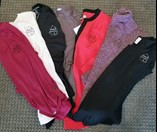Coordinating Couture

Over the years, coordinating apparel has gotten a bad rap. The term may conjure up images of cringe-worthy family portraits where everyone is dressed the same, or identical outfits that siblings—especially twins—may be forced to wear growing up, or even the over-the-top ensembles sported by ’90s boy bands.
But coordinated apparel is not necessarily about matching others or adhering to a rigid color-coding system. Instead, combining apparel pieces that are compatible in their color palettes and textures creates a look that is harmonious and put-together. To get a coordinated look, it’s best to avoid styles that are too “matchy-matchy,” and don’t be afraid to add an unexpected pop of a contrasting color, texture or pattern, particularly with accessories.
On the retail side, an interest in coordinating apparel is on the rise. To help consumers take the guesswork out of matching different fabrics and staying current, retail clothing subscription services have become popular in the United States. Stitch Fix is one example of such a service, where consumers create an online profile and then receive a regular shipment of garments that have been selected for them by a stylist. Another option is Infinite Style by Ann Taylor, which sends subscribers coordinated outfits they can rent and then return. The idea is to simplify dressing and allow busy consumers to avoid the hassle of hitting the mall, or guessing what pieces work together when shopping online.
In the promotional industry, coordinating apparel is essential for corporate apparel programs, teams and athletic events, and it includes separates that work together as well as similar pieces for men, women and youth.
“Consumers today want quality apparel, and fit is super important,” says Marcus Davis, product development manager for supplier Hanes/Champion (PPAI 191138). “It’s imperative to offer flattering, appropriately-sized styles for a variety of shapes and sizes. For example, we offer coordinating lightweight ring-spun tees in youth, men’s, women’s, and women’s plus sizes within Hanes Black Label apparel.”
Lauren Cocco, director of merchandising for supplier Vantage Apparel (PPAI 113235), says, “We merchandise our collection to give lots of wardrobe options. Coordinating apparel programs often use matching items for men and women, a combination of different product categories in coordinating colors, or complementary fabrics and colors but in different silhouettes.”
---
Color Hacks
When deciding what apparel pieces work together, sometimes it’s best to go back to the basics.
The color wheel is one of the first things that children are introduced to in their early learning years. The wheel was developed by Sir Isaac Newton in 1666, when he discovered that white light contains the full spectrum of colors.
The traditional color wheel has 12 colors, classified as follows:
- Primary: red, yellow and blue
- Secondary: orange, green and purple
- Tertiary: yellow-orange, red-orange, red-purple, blue-purple, blue-green and yellow-green
Color theory includes a legion of complicated concepts, but one of the most basic is color harmony. According to colormatters.com, color harmony is achieved when a mixture of colors engages while also maintaining a sense of order. The two most common formulas for color harmony include:
- Analogous colors: choose any three colors that are side by side on the color wheel.
- Complementary colors: choose two colors that are directly across from each other on the color wheel.
Following one of these two formulas is a foolproof way to combine colors in a way that is guaranteed to be pleasing to the eye. Maybe we did learn everything we need to know in kindergarten.
---
What’s In Store For Company Stores
Company stores typically offer coordinating apparel to ensure a coherent look among employees and to communicate a consistent corporate brand. PPB asked the experts what clients want from company stores now. Here’s what they revealed.
The biggest trend we’re seeing with company stores is paring down the number of items to better represent the company brand. We’re finding that most clients are looking for a sense of uniformity and synergy with their company culture. For instance, if the culture is more casual or edgy/hip, they may only provide items such as t-shirts, shorts, flip flops, trucker hats and polo shirts with a modern cut. If they have a more formal company culture, they tend to only add products such as button-down shirts, sweaters, golf attire and desk accessories.
In the past, many clients would add a large variety of items to their company stores to give employees more options to choose from. In most cases, paring down the total number of items also allows for ease of ordering and inventory control.
—Blake Bozeman, MAS, director of sales, SAGE
Two trends are striking:
1. First, the trend toward the fast and efficient launch of a company store that allows employees to quickly and easily order products while simultaneously reducing the workload on the distributor with respect to managing these types of programs. No longer does a customer need to push six figures in sales to warrant the introduction of a company store into their program.
2. Second, the trend toward more creative and modern apparel selections. The days of standard embroidery on the left chest of a unisex polo are quickly being replaced by unique, complementary styles for men and women in modern performance materials. Fresh, bright colors are hot; casual performance fabrics are hot; and cutting-edge decorating techniques such as laser etching, laser applique, 3D full color logos and tech patches are hot.
—Jason Nokes, president, DistributorCentral
We’ve always noticed that company store apparel sales closely follow ecommerce trends. We often see office wear or uniforms as a key component of company store sales. What is most important to us is that we offer a solution that makes ordering apparel, in all of its many variations, easy and intuitive for the shopper as well as for the distributor.
—Tanya Ignacek, vice president, BrightStores, Inc.
---
Case Study

Spoiled For Choice
A business was introducing a product line of certified organic and botanical essential oils, hydrosols and skin care, and the owner wanted to offer employees a selection of coordinating shirts to choose from to wear on the job.
American Solutions for Business recommended retail-inspired triblends and ring-spun cotton fabrics that have a soft hand. The client chose a variety of styles featuring different sleeve lengths and cuts that work for both slim and full body types. The goal was for every employee to have flattering options they would be excited to wear.
“Women don’t want a smaller semi-tailored version of a man’s shirt anymore, and it’s important that our industry understand this,” says Kristina Beal, sales associate for American Solutions for Business. “When it’s on trend, comfortable and good quality, the workforce becomes an even bigger asset by wearing their logowear while they are out in the community living life outside of the office.”
Source: American Solutions for Business
---
Terry Ramsay is associate editor of PPB.

